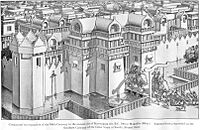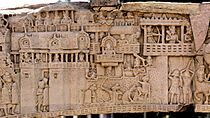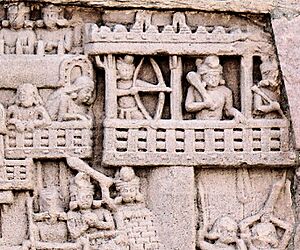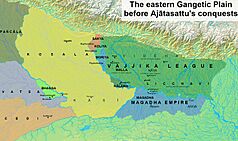Malla (tribe) facts for kids
Quick facts for kids
Malla Republic
|
|||||||
|---|---|---|---|---|---|---|---|
| c. 7th century BCE–c. 4th century BCE | |||||||
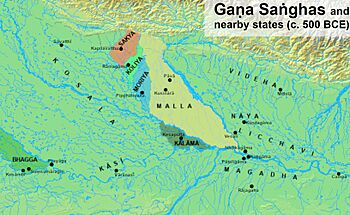
Malla among the Gaṇasaṅghas
|
|||||||
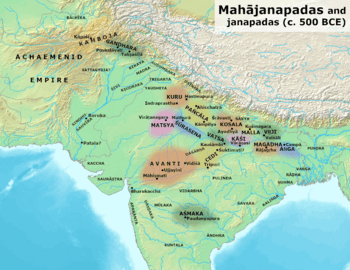
Malla, Vajji (the dependencies of Licchavi within the Vajjika League), and other Mahajanapadas in the Post Vedic period
|
|||||||
| Capital | Kusinārā Pāvā |
||||||
| Common languages | Prakrit | ||||||
| Religion | Historical Vedic religion Buddhism Jainism |
||||||
| Government | Republic | ||||||
| Gaṇa Mukhya | |||||||
| Historical era | Iron Age | ||||||
|
• Established
|
c. 7th century BCE | ||||||
|
• Disestablished
|
c. 4th century BCE | ||||||
|
|||||||
| Today part of | India | ||||||
The Malla people were an ancient group from the northeastern part of the Indian subcontinent. They lived during the Iron Age. The Malla people, also called the Mallakas, were split into two main groups. Each group was like a small republic, ruled by a few important families. These were called the Malla Republics, and they were part of a bigger group called the Vajjika League.
Contents
Where Did the Malla People Live?
The Mallakas lived in an area that is now part of the Gorakhpur district in India. We don't know their exact borders, but we know their neighbors. To the east, across the Sadānirā river, were the Licchavikas. To the west were the Sakyas, Koliyas, Moriyas, and Kauśalyas. South of them were the Kalāmas and the Gaṅgā river. The Himālaya mountains formed their northern border. Their land was located between the Vaidehas and the Kauśalyas.
The two Malla republics were separated by a river called Hiraññavatī. One republic had its capital at Kusinārā, which is now the village of Kāsiā. The other capital was at Pāvā, now known as Fazilnagar. Kusinārā was close to the Sakya capital, Kapilavatthu. Pāvā was near the Licchavika capital, Vesālī.
What Was the Malla Name?
The Malla people are called Malla in Pali texts. In Jain Prakrit texts, they are called Mallaī. In Sanskrit texts, they are also known as Malla.
History of the Malla Republics
How the Malla States Formed
The Mallakas were an Indo-Aryan group living in the eastern Gangetic plain. This area was part of the Greater Magadha cultural region. Like other groups in this area, the Mallakas were not fully following Brahmanism at first, even though they were Indo-Aryan. But later, they adopted Brahmanism.
Over time, the Mallakas split into two separate republics. One had its capital at Kusinārā, and the other at Pāvā. This split might have happened because of internal problems. The two Malla republics didn't always get along well.
However, both Malla republics joined the Vajjika League, which was led by the Licchavis. Unlike some other members, the Mallakas kept their own independence. They were not conquered by the Licchavikas. The Mallakas had good relationships with the Licchavikas, Vaidehas, and Nāyikas, who were also part of this league.
Sometimes, there were small disagreements between the Mallakas and the Licchavikas. For example, a Mallaka man named Bandhula became a general for King Pasenadi of Kosala. This was to keep good relations between the Mallakas and Kosala. Bandhula and his wife, Mallikā, used a sacred pool of the Licchavikas without permission. This led to fighting between Kosala and the Licchavikas. Later, King Pasenadi had Bandhula and his sons killed. To get revenge, some Mallakas helped Pasenadi's son, Viḍūḍabha, take over the throne of Kosala. Pasenadi then fled and died.
The Buddha visited Pāvā shortly after the Mallakas there opened their new meeting hall, called Ubbhataka. From Pāvā, the Buddha and his followers traveled to Kusinārā. On their way, they crossed two rivers: the Kakutthā and the Hiraññavatī. The Hiraññavatī river separated the two Malla republics.
The Buddha spent his last days in the Malla republic of Kusinārā. When he sent his follower Ānanda to tell the Mallakas of Kusinārā about his upcoming death, Ānanda found their council meeting about public matters in their meeting hall.
When Ānanda returned to the Mallakas of Kusinārā to tell them the Buddha had passed away, they were meeting to plan his funeral. After the Buddha's body was cremated, his remains were honored in Kusinārā's meeting hall for seven days. It was here that envoys from Magadha, Licchavi, Shakya, Buli, Koliya, the Mallakas of Pāvā, and Moriya came. They all wanted a share of the Buddha's relics.
The Licchavikas, the Mallakas, and the Sakyas received shares of the relics. Other members of the Vajjika League, like the Vaidehas and Nāyikas, did not claim a share. This was because they were dependent on the Licchavikas and did not have their own independent power. The Mallakas of Pāvā were the first to arrive with an army. They demanded their share of the relics in a very strong way. In the end, each Malla republic got a share of the Buddha's relics. They built their own stūpas (dome-shaped shrines) and held feasts to remember this event.
After the death of Mahāvīra, a great leader in Jainism, the Mallakas and Licchavikas together started a festival of lights to remember him.
Decline of the Malla Republics
The Licchavikas led the Vajjika League, which included the Mallakas. At first, their relationship with the kingdom of Magadha was good. The Magadhan king, Bimbisāra, was married to a Licchavika princess. However, there were occasional tensions. For example, there was competition over the Buddha's relics at Kusinārā after his death.
At one point, the Licchavikas even invaded Magadhan territory. Eventually, the relationship between Magadha and Licchavi became very bad. This was due to a serious offense committed by the Licchavikas against King Bimbisāra.
The fighting between Licchavi and Magadha continued when Ajātasattu became king of Magadha. Ajātasattu was Bimbisāra's son. He had killed his father and taken the throne. The Licchavis supported a rebellion against Ajātasattu by his younger step-brother, Vehalla. Vehalla was also a Licchavika prince. The Licchavikas tried to put Vehalla on the throne of Magadha. They allowed him to use their capital, Vesālī, as a base for his revolt. After the rebellion failed, Vehalla sought safety with his grandfather in Vesālī. Ajātasattu tried many times to make peace with the Licchavikas and Vajjikas. When his attempts failed, he declared war on the Vajjika League in 484 BCE.
One reason for the conflict was how the Vajjika League managed the border post of Koṭigāma on the Gaṅgā river. The Licchavika-led Vajjika League would take all the valuable goods from Koṭigāma, leaving nothing for the Magadhans. Ajātasattu decided to destroy the Vajjika League in revenge. He also wanted to expand his empire and take over the territory of the former Mahā-Videha kingdom, which was part of the Vajjika League. Ajātasattu's dislike for the Vajjika League also came from their different ways of governing. Magadha was a kingdom ruled by a king, while the Vajjika League was a republic. This was similar to how the kingdom of Sparta in Ancient Greece opposed the democratic government in Classical Athens.
As important members of the Vajjika League, the Malla republics were also in danger from Ajātasattu. The Vajjika leader, Ceḍaga, held war meetings with the leaders of the Licchavikas and Mallikas before the fighting began. So, the Mallakas fought alongside the other groups in the league against Magadha.
At first, the Vajjika League's army was too strong for Ajātasattu. He had to use clever plans and tricks for ten years to finally defeat the Vajjika League by 468 BCE. He then took over their lands, including Licchavi, Videha, and Nāya, adding them to the kingdom of Magadha. The Mallakas also became part of Ajātasattu's Magadhan empire. They were allowed some control over their local government. However, they stopped being a republic when the Maurya dynasty ruled Magadha, or shortly after.
How the Malla Republics Were Organized
Republican Institutions
The Assembly
Like the Vaidehas, Licchavikas, and Nāyikas, the Mallakas were a kshatriya (warrior/ruler) group. Each Malla republic was organized as a gaṇasaṅgha. This meant it was a republic ruled by a few important families. The ruling Assembly was made up of the heads of the kshatriya clans. These clan heads were given the title of rājā (ruler).
The position of rājā was passed down through families. When a rājā died, his oldest son would take his place. For the Mallakas of Kusinārā, this involved a ceremony at the Makuṭa-bandhana, a special shrine. The Mallakas of Pāvā had a similar shrine. The Mallaka General Assembly had many members, but not all of them attended meetings often.
The Malla republics, like other gaṇasaṅgha in the Vajjika League, held their Assembly and Council meetings in their own meeting halls called santhāgāras.
The Councils
Like the Licchavikas, the Mallakas' main Assemblies met rarely. Instead, smaller councils, which were part of the Assemblies, met more often. The Mallaka Council for Kusinārā had four members, and the one for Pāvā had five. These councils managed the daily public affairs within each republic. They were the main governing bodies of the Malla republics.
Customs
An ancient text called the Manusmṛiti referred to the Mallakas as Vrāṭyakṣatriyas. This meant they were kshatriyas who had not completed certain traditional ceremonies. This was because they did not follow all the orthodox Vedic traditions.
See also
- Kingdoms of Ancient India
- Mallabhum


